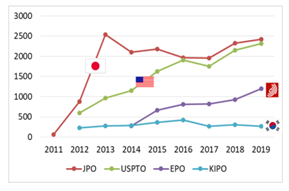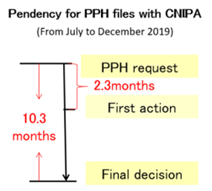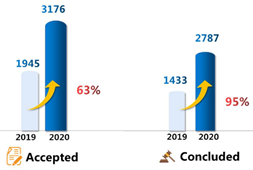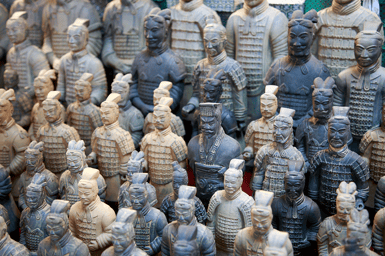Patent Protection in China: Myths vs Reality
 After having visited the Dutch horticultural sector at the end of October 2021, Jack Ma, the co-founder and main man behind Alibaba, honoured our country with another visit on 2 July. This time he visited Wageningen University. That Ma is a smart guy. He initially became successful with his Internet companies and is now starting to focus his attention on agriculture and sustainable food production in China. Around when he came last year some media outlets felt that they had to frame his visit in a negative way with headlines such as: 'Is the Chinese Alibaba CEO 'stealing' secrets from Westland glasshouse horticulture? 'These headlines reflect the persistent misconceptions about China as a country of copycats that is not too bothered about patents. It is now a time to express an opposing view and to dismantle two persistent misconceptions.
After having visited the Dutch horticultural sector at the end of October 2021, Jack Ma, the co-founder and main man behind Alibaba, honoured our country with another visit on 2 July. This time he visited Wageningen University. That Ma is a smart guy. He initially became successful with his Internet companies and is now starting to focus his attention on agriculture and sustainable food production in China. Around when he came last year some media outlets felt that they had to frame his visit in a negative way with headlines such as: 'Is the Chinese Alibaba CEO 'stealing' secrets from Westland glasshouse horticulture? 'These headlines reflect the persistent misconceptions about China as a country of copycats that is not too bothered about patents. It is now a time to express an opposing view and to dismantle two persistent misconceptions.
The misconceptions in a nutshell
Let's start with the two prevailing misconceptions. After that I will explain why each of these misconceptions should be swept aside as quickly as possible.
- China is said to be a country that just copies everything and does not actually invent anything itself.
- China is also said to be a country that is not bothered about patent rights
The first misconception: China is said to be a country that just copies everything and does not actually invent anything itself
The first persistent misconception. We invent something clever in the West, and in no time China will produce a perfect copy. In reality the situation is quite different now. China itself is actually rapidly innovating. More and more high-tech inventions have their origin in China. There are many Chinese inventors in the field of Internet-related developments, telecoms, Artificial Intelligence and Big Data, among other things. More and more inventions in all kinds of other fields are now also coming from China.
Chinese companies filing patent applications
At the same time, the number of high-quality patent applications from China is also increasing. They have an increasingly better understanding of the patent system, which enhances their competitiveness. In China more than 1.5 million(!) Chinese patent applications are currently being filed each year of which the large majority come from Chinese companies themselves.
A growing number of these are for inventions which after substantive review also prove to be novel and inventive, and are therefore rewarded with exclusive patent rights. In 2021 China granted nearly 700,000 patents of which a large proportion came from Chinese companies themselves. China is also gaining a foothold in Europe. When you look at the total number of patent applications, Chinese companies now have a 9% share and Dutch companies a 3% share in these.
More and more of these patent positions are also transferred to Europe. The share of European patent applications filed by Chinese companies has now risen to 7% (compared to the Netherlands which is 4%).
Chinese high tech inventions
I deal with some of these Chinese inventions myself, and come across a really diverse range of inventions. Inventions such as:
- a system for multi-bit quantum feedback control
- a user device based Parkinson disease detection
- an image processing method based on artificial intelligence
- a method and device for generating a neural network model
- a virtual object control method and apparatus
- a lane selection method for target vehicle
Just to be able to properly understand this type of invention you need to do a great deal of research, and fortunately I have a whole team of specialists to help me with that.
High time to reconsider the first misconception
At the same time, my admiration and respect for the creativity and out-of-the-box thinking of Chinese inventors in the most complex fields is also growing. China is rapidly transforming into a self-innovating nation that also recognises the benefits and importance of good patent protection.
The second misconception: China is also said to be a country that is not bothered about patent rights
The second persistent misconception is that it makes no sense for a Western company to apply for a patent in China as China does not really care about them. Apparently, it is a waste of money because they would start copying the invention in China anyway and would not respect any patent rights in the process. It is an unfair stigma. In reality the situation is quite different now.p>
IP5 cooperation
The five leading patent granting authorities in the world are:
- the United States Patent and Trademark Office (USPTO)
- the China National Intellectual Property Administration (CNIPA)
- the European Patent Office (EPO)
- the Japan Patent Office (JPO)
- the Korean Intellectual Property Office (KIPO)
It is not without reason that China is one of them. These IP5 have been working together on harmonisation and ways to improve quality, service and efficiency in the field of patent protection for several years now.
Patent Prosecution Highway (PPH)
The IP5 furthermore have a significant Patent Prosecution Highway which enables them to speed up the granting procedure. They do this by using each other's official novelty search. This leads to greater uniformity in the scope of protection and also, most importantly, to cost savings for patent owners and a workload reduction for examiners.
Below you can see how much use is already being made of this Patent Prosecution Highway in China:


It has also been shown that it helps to significantly shorten the granting procedure in China.
Specialised courts
China has also undergone major developments in the field of its patent jurisdiction. There are three specialised patent courts in China that handle infringement cases, namely in Beijing, Shanghai and Guangzhou. I have been to each of these cities.
More than 5000 patent cases were filed with these specialised patent courts last year. Only 8% of these were filed by Western companies. Most of the litigation involved disputes between Chinese companies. The number of judges, mostly technically and legally trained in patent law, is so high that they have to deal with around 80 patent cases per judge per year.

The majority of these disputes ended in a settlement. Of those cases that required a court ruling, analysis shows that Western companies certainly do not need to be afraid that their Chinese opposing party is going to be favoured. The number of cases won by Western companies is simply too high for this to be the case (over 70%).
Personal experience
I myself was also involved in a patent case for an SME in China in which it was not possible to reach a settlement and we had to fight until the bitter end. It turned out to be a positive experience and we actually managed to win the case more easily, more quickly and more cheaply than I had thought possible.
At the time, the most important thing was an infringement ban and the destruction of the production moulds (it concerned a multi-material injection moulding product) to ensure that no infringement of the same product could occur elsewhere at some point in the future. Unfortunately, at that time it was not yet possible to claim serious amounts of damages. However, in June 2021, the possibilities to do so were further expanded and, in addition to loss of earnings, substantial damages can now also be claimed and awarded.
High time to reconsider the second misconception
In terms of quality the Chinese Patent Office is, for instance, definitely not inferior to the European Patent Office. They work very meticulously and professionally. In addition, it is most certainly possible to tackle patent infringements in China. Specialist, experienced Chinese patent judges administer justice in patent cases without regard to nationality.
When you consider the large volume of cases, my admiration and respect for how quickly China has been able to accomplish this increases. China is not only rapidly transforming into a self-innovating nation, but is also offering Western companies the same legal certainty that innovative Chinese companies can expect and receive in the West.
Patent protection strategy for China now
Of course it is also a legitimate choice to conquer China with your invention without applying for a patent in China. This can be done, for example, by trying to keep crucial information about it secret as much as possible. In many cases, however, it is virtually impossible to do so and it is relatively easy to discover the invention by means of reverse engineering.
It is then not possible to arrange patent protection in China retrospectively. In the context of third party legal certainty this should be initiated before you go public with the invention. Without patent protection in China, anyone is free to copy, manufacture, sell or use your invention in China. You will then be forced to compete entirely on price, quality and service.
You may also suddenly find yourself in a situation in China where someone else has exclusive Chinese patent rights for a similar invention. This is perfectly legitimate when you have not applied for a patent and as long as the invention claimed by the other party meets the worldwide novelty and inventive step requirements. Just imagine: in this scenario you would no longer be able to earn any money in China from your own invention.
Protection strategy 2.0
Many of my clients are now well aware of the opportunities and threats from China in the field of patent protection. By starting with protecting on the Dutch home market they get a good feel of their chances of success with the innovation. They often decide to extend the patent protection to other countries after this. In the first place to Europe, followed by the US. The third most popular country is China. So China comes before countries such as Australia, Canada, Japan and Korea.

And with good reason, because the Chinese patent protection appears to be working well for them these days:
- They obtain exclusive rights for a huge market, i.e. China itself. These exclusive rights apply to the production, construction, installation, sale and commercial use in China itself.
- This ensures that their invention cannot be manufactured by others in China, even if this is purely for export to other countries outside China.
- It makes it a lot easier and safer for them to talk to several manufacturers and/or market players in China and to exchange knowledge about their invention with them. Even after sharing knowledge about their invention, they continue to have the exclusive patent rights in China.
- This helps prevent a situation in which someone else obtains exclusive Chinese patent rights for a similar invention, which could otherwise even result in their own invention being blocked.
Three protection options for patents in China
The advantages of having your own Chinese patent rights are so great that they should be given due consideration.
Please note that there are three options for protecting your invention in China:
- Invention patent;
- Utility patent; en
- Design patent.
Each of these comes with its own requirements, scope of protection and cost. They can also be applied for simultaneously.The invention patent is for fully-fledged inventions that must be able to pass both a novelty and inventive step test. The utility patent is for improvements that are novel but only need to have a more limited inventive step. The design patent is for external design. The latter two are cheap and fast registration rights.
Keep innovating
The advantages of having your own Chinese patent are so great that I hope you will abandon any preconceptions and also consider applying for a Chinese patent. You should then always seek the advice of an expert who is familiar with the protection options in China.
And once you have that Chinese patent? Do not rest on your laurels but keep innovating! Make sure you are a trendsetter within your sector. Develop smart solutions to problems and then protect them in the best way possible so that you are once again assured of a new period of exclusivity even after the maximum period of protection has expired.

About the author
Since joining EP&C in 1994, I’ve enjoyed working with passionate inventors across a broad range of technologies. My background in mechanical engineering equips me to analyze innovations down to their...
More about Rudi >